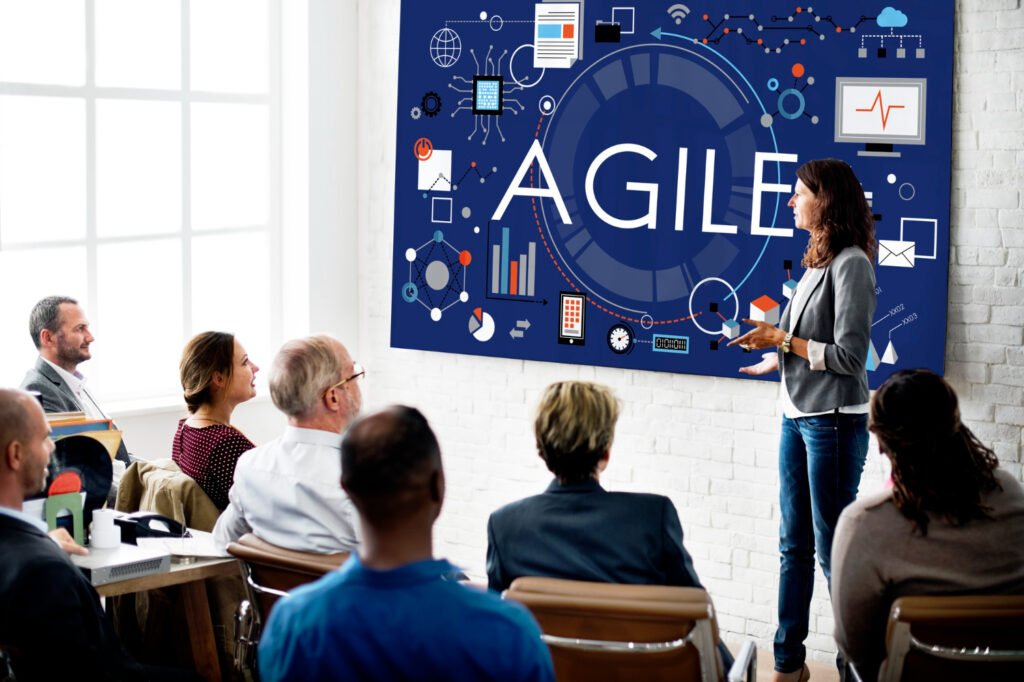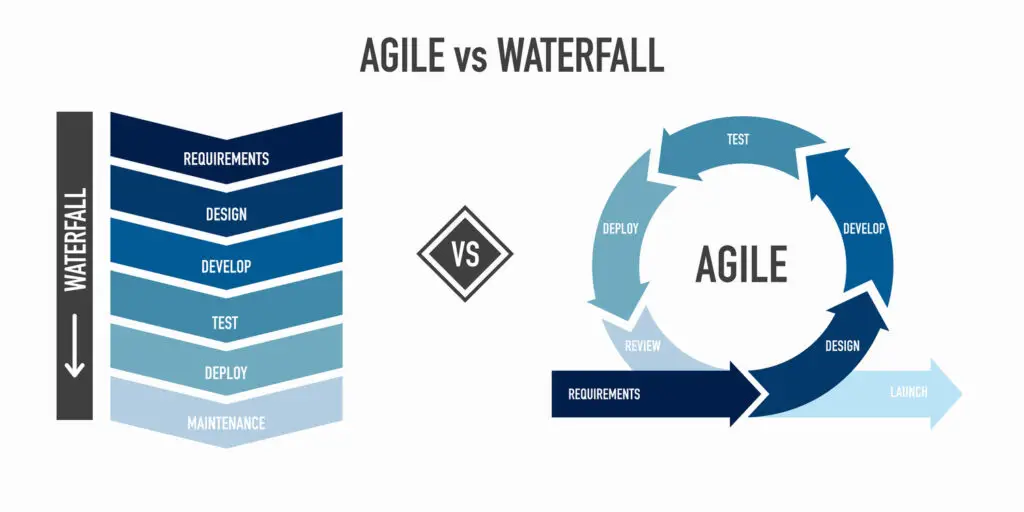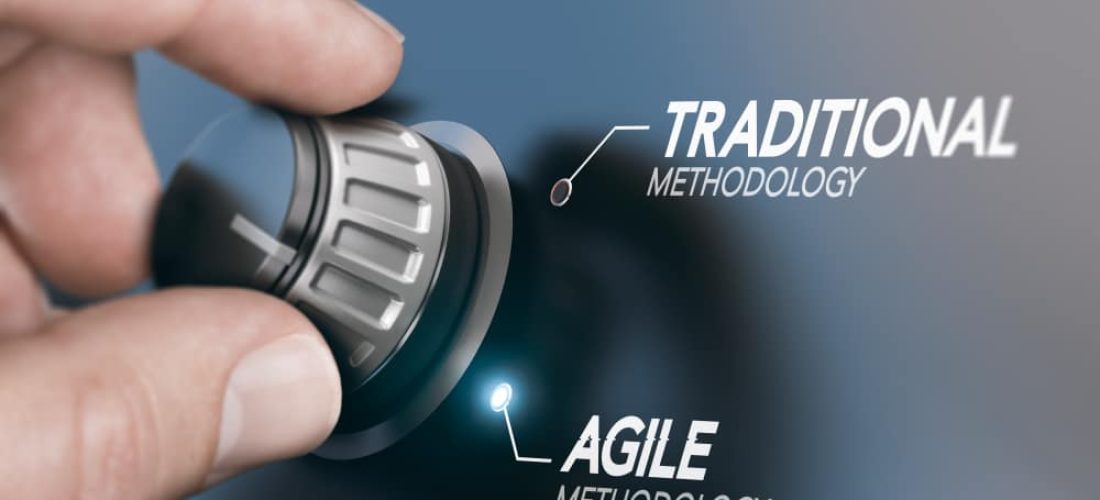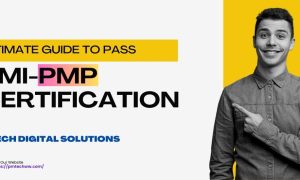Agile Vs Waterfall methodologies are for planning a project and its management. When it comes to selection, choosing the right methodology is essential for its success. Agile and Waterfall are two well-known approaches that each come with their own advantages and disadvantages. Deciding which one to employ depends on what’s best suited to your development team’s needs. It is important, then, to take into account all relevant information in order to make an informed decision about this crucial element of effective project management.
Key Takeaways
-
Agile and Waterfall methodologies differ in terms of flexibility, structure, and ability to incorporate changes.
-
Project managers must consider factors such as team composition and customer expectations when selecting an approach.
-
Hybrid approaches combining Agile & Waterfall may be used depending on the specific needs of the project for successful outcomes.
Navigating Your Best Project Management Approach

Waterfall methodology is an approach to project development which involves linear steps and a strong focus on having clear documentation. In this method, projects pass through phases of initiation, planning execution, control/monitoring and closure without much opportunity for adjustments along the way. This structure makes it more suitable when there are precise requirements in terms of complexity and timeline present. Its rigidity can create difficulties if modifications become necessary while executing a given project.
The Linear Path of Waterfall
The Waterfall Model follows a rigid, ordered set of stages with no leeway for revisiting prior steps or making changes during the process. These six phases are Requirements Gathering, Designing, Implementing, Testing and Debugging, Deployment and Maintenance. This sequential approach can help make sure tasks get completed in good time, but also may not leave room to accommodate issues that come up unexpectedly or permit fresh ideas along the way.
Emphasis on Documentation
When it comes to Waterfall projects, producing thorough documentation is essential for proper communication and comprehension of the project’s demands. A good plan and extensive records covering tasks progress, requirements etc make sure that outcomes are consistent in quality as well as provide a benchmark for future undertakings. Project plans, requirement documents, design docs, test plans, and user manuals represent the kind of information needed when working on such initiatives. This detailed approach helps ensure clear conversations about objectives while also aiding knowledge exchange between parties responsible for maintenance or Development in this area afterwards.
It should be noted how different this emphasis on paperwork makes Waterfall from alternative methodologies like Agile which puts more focus on team work instead of having plentiful documentation.
When Waterfall Shines
The Waterfall approach is best for when you have a project with well-defined goals, minimal changes and timelines that can be predicted. Shorter projects which do not necessitate lengthy deadlines or having to go through certain stages each time are optimal candidates for utilizing this method.
For example, the Universal Credit welfare reform in Britain cost an initial £2.2 billion. It stuck to the Waterfall methodology due to its linear construction allowing successful results since conditions remained static throughout as did their expectations of completion dates.
Related: Project Management: Unlocking Organizational Performance & Efficiency
Decoding Agile Methodology

Agile methodology is a project management approach that emphasizes collaboration and flexibility. It involves delivery in several sprints, allowing for an ongoing review of the plan’s requirements and results along with fast adaptation to changes. This method has become popular amongst technical teams such as IT support crews or software engineers because it can manage budgetary uncertainties, timetables, and resources effectively. Making Agile development particularly suitable for them.
Iterative Cycles in Agile
Agile methodology uses cycles, or sprints, to develop and deliver small project increments that allow for ongoing refinement. Every cycle has a set period which contains planning tasks/user stories execution as well as reviews plus an assessment + postmortem at its end in order to generate feedback and prepare advancements ahead of the subsequent round. This iterative approach encourages teams to cooperate while organizing their priorities. Changes can also be done based on customer reviews and changing necessities – all these combining together to promote adaptability towards better results. This system gives way for flexibility when required with continuing improvement opportunities at hand too!
Agile’s Flexibility
Agile methodology has been commended for its flexibility, which enables it to quickly accommodate varying conditions. This makes Agile an ideal approach for projects that demand recurrent change and iteration. To deal with abrupt changes in the market environment, teams can put into place strategies across iterations, have a vision concerning alterations, and empower self-organizing squads. As well as escalate their proficiency in responding to supply/demand imbalances. By allowing modifications within agile ventures and by approving adaptability, this process is able to give customers what they need – greatly improving project prospects and outcomes.
Customer Collaboration in Agile
Agile teams emphasize customer collaboration throughout the development process, ensuring their end product will meet all needs and expectations. Techniques such as transparency in communication between cross-functional groups facilitate a feedback loop for constant input from customers. Collecting this information is then documented to be used by agile teams for quickly making changes if needed or desired, resulting in higher levels of customer satisfaction and loyalty.
Related: Mastering Agile Methodologies: Ultimate Guide to Transformative Project Management
Agile Vs Waterfall Methodologies

Project management practices such as Agile and Waterfall have a few major distinctions between them in terms of how they deal with project execution, development phases and the ability to make changes. The iterative nature of Agile encourages collaboration throughout its duration while allowing adaptability when needed whereas on the other hand, Waterfall’s approach is structured linearly which involves completing one phase completely prior to advancing onto another.
In Detail, we can analyze these differences better so that their influence over various aspects concerning projects is more clear-cut.
Approach to Project Management
Project management is an area in which agile and waterfall methodologies differ, as they employ different approaches. Agile takes on a more flexible form with continuous improvement while Waterfall implements structure through its six definitive steps: requirements, design, implementation, testing, deployment and maintenance. To the changeable environment of agile methodology however. Waterfall remains linear throughout all these processes whereas it allows for greater adaptation when project plans shift or need alteration due to backlog items being changed during iterations. All-in-all both forms are considered beneficial depending upon your individual circumstances, but there remain stark differences between them – that’s what makes each so effective in their own right!
Related: Decoding the Role of PMO: Key Factors in Project Success
Execution of Development Phases
In Agile methodology, the development phases are completed simultaneously, which permits for stepwise testing and ongoing communication with stakeholders throughout the creation. This iterative system lets groups work together, order projects by importance, and implement changes based on feedback or modified demands.
On the other hand, in Waterfall methodology, all stages of advancement must be finished before progressing to the subsequent level. Making it hard to integrate alterations after a section/phase is concluded, potentially delaying activities and raising the cost associated with project completion.
Adaptability to Project Changes
The agile model, referred to as the agile methodology or method, is renowned for its collaborative and flexible approach which allows simultaneous work in different stages of the project with continuous improvements. This enables companies to rapidly deliver customer value while simultaneously adapting requirements.
In contrast, Waterfall methodology places an emphasis on meticulous planning and documentation. Making it more appropriate when a task has predetermined features or requires strong predictability. Its strict design can cause problems if substantial enhancements are required at later parts of the process.
Agile vs Waterfall: The Project Manager’s Perspective
Project managers should consider aspects such as team composition and customer needs when evaluating agile versus waterfall techniques. Agile approaches are advantageous for teams that have a combination of roles, are self-regulating, and can collaborate with stakeholders throughout the process. Conversely, waterfalls offer distinct advantages to groups which prefer an ordered approach but with fixed requirements.
The following parts go on to discuss this in greater detail including how these elements affect project management decisions between agile or waterfall methods.
Evaluating Team Structure
Software development teams must have an effective structure when selecting the ideal methodology, as Agile requires flexible and cross-functional groups whereas Waterfall needs more structured and specialized ones. As part of this, Agile Teams often involve three central roles: Scrum Master/Team Lead, Product Owner, Developers or Team Members, who collaborate to provide value together.
In contrast, in a traditional software team context for Waterfall methods, there are four specific positions – Developer, Tester Business Analyst plus Project Manager – that handle distinct responsibilities within the group dynamic.
Managing Customer Expectations
Project managers should be aware of the capabilities and drawbacks of both Agile and Waterfall methodologies when it comes to meeting customer expectations. When using an Agile approach, feedback from customers is invited on a regular basis, allowing for scope changes if necessary based on market trends. On the other hand, with a Waterfall system, rigid requirements are usually set at first so changing these midway can prove difficult in terms of accommodating altered demands. By being knowledgeable about how each framework deals with customer expectation management decisions regarding what methodology works best for any given project can more easily be made by those who oversee them.
Integrating Agile & Waterfall: Is a Hybrid Possible?

In certain circumstances, integrating the strengths of Agile and Waterfall methodologies into a hybrid approach may be best suited for specific project requirements. This type of blend between structure and flexibility could provide an advantageous balance based on what’s needed by that individual project.
The following parts will analyze how successfully combining both agile and waterfall techniques can potentially work in practice through examples from case studies utilizing these methods together.
Combining Methodologies
Integrating agile and waterfall approaches in a project can help achieve the necessary balance between flexibility and structure. This blending of methodologies may take the form of ‘Water-Scrum-Fall’ or ‘Hybrid Agile Waterfall’. The aim is to use linear/sequential progression from traditional Waterfall for some aspects, then complement with elements from agile development such as iteration. It’s key that each case gets adapted uniquely depending on its specific needs. To do so successfully will require combining both frameworks together tactfully while retaining their distinctive features. Incorporating both agility as well as waterfall principles into operations at an appropriate level according to what suits best.
Case Studies of Hybrid Approaches
Case studies of combining Agile and Waterfall methodologies have demonstrated the potential advantages they may offer in numerous industries and projects. Philips, for instance, made use of a hybrid approach when designing its HealthSuite digital platform to capitalize on both methods’ merits. Thus optimizing the final result.
By examining these case studies we can learn how best to employ this combined strategy depending upon particular project requirements.
The Role of Software in Agile & Waterfall Projects

Project management software solutions can have a big effect on facilitating both Agile and Waterfall project administration strategies for programming development ventures. Groups following the Agile strategy can take advantage of venture supervising apparatuses that emphasize collaboration, correspondence, and consistent progress whereas teams utilizing Waterfall techniques may use software designed to provide specific record-keeping capabilities such as detailed planning outlines or tracking milestones.
Below are outlined two separate categories exploring program devices applicable in each framework – one being relevant to an agile approach while the other focusing on needs associated with waterfall projects.
Tools for Agile Teams
Project management software specifically tailored to Agile teams can be an invaluable asset. Such platforms feature various components that make adhering to agile project methodologies more efficient, such as task organization and reporting capabilities. Popular applications of this type include Jira, Nutcache, and Trello among others.
To the above-mentioned solutions for managing tasks within a team, collaboration tools like Slack are great aids in fostering open communication between members, which promotes continuous improvement throughout the lifetime of your agile project(s). This helps create cohesion among peers striving towards common objectives by offering them all access resources they need with just one click away!
Solutions for Waterfall Projects
Software solutions designed to manage project details, plan thoroughly and track progress are essential for successful Waterfall projects. Solutions like ClickUp, Asana, Microsoft Project, interactive Gantt charts that give teams visibility into the entire project strategy as well as lists of tasks and timelines which help them monitor accomplishment over time.
By making use of these software tools available today a dedicated team is able to oversee efficient management processes throughout their waterfall-style operations while maintaining all important facts related to it such as task completion status resulting in desired outcomes from each given activity along with general productivity increase going forward.
Making the Right Choice: Agile Vs Waterfall for Your Team
When it comes to selecting the most fitting project management methodology for a development team, factors such as customer expectations, specific project requirements and the structure of that particular team must all be taken into account. Familiarizing yourself with both Agile and Waterfall strategies can ensure you make an informed decision based on their advantages/disadvantages while ensuring your crew is equipped to handle any task they are presented with.
By closely considering these components when making your selection between agile or waterfall procedures, teams can complete projects punctually while satisfying stakeholders economically speaking.
Agile vs Waterfall: Impact on Delivering Business Value
The Agile and Waterfall methodologies both provide different benefits that can be utilized to enhance the delivery of business value. Agile emphasizes more adaptability, collaboration, continuous improvement, and faster value-based deliveries. Waterfall offers a structured approach for projects requiring high levels of predictability or those with static requirements. Understanding how each methodology can benefit your project is crucial in order to get optimum results from delivering useful services and achieve success within time constraints. Opting between either one greatly affects the capacity of any given venture when it comes to yielding its expected outcomes in terms of values, so making an informed decision on which best fits your scenario should not be taken lightly.
Related: Mastering Portfolio Management: Strategies for Optimizing Your Investments
Summary
Ultimately, when selecting a project management approach for your development team, it is important to consider the differences between Agile and Waterfall methodologies. Agile encourages flexibility through an iterative process while Waterfall follows linear steps. Understanding these nuances as well as other factors such as customer expectations can help you choose the best methodology that meets all needs and delivers maximum business value. With careful selection of software tools, you can use a variety of tools. To choose either Agile or Waterfall approaches, project delivery will likely exceed stakeholder goals successfully.
Frequently Asked Questions
What is the difference between Agile Vs Waterfall project success?
Agile projects built on being adaptive and incremental stand in stark contrast to Waterfall initiatives with their strictly defined steps. Consequently Agile solutions are more successful than those developed through a waterfall approach due to the additional flexibility they bring. Rather than meticulously detailing every element prior to implementation, as required by waterfall methodology. Agile development allows for quicker yet well-informed decisions that can easily be changed should any new information become available or circumstances change.
What is the main advantage of the Waterfall methodology over the Agile approach?
The Waterfall methodology is beneficial due to its well-defined objectives, which prevent costly modifications as a project progresses and emphasizes reducing waste in contrast to the Agile approach.
What is an example of Waterfall methodology?
Waterfall methodology is a process that can be seen in the building industry, where specific tasks need to follow one another. For instance, painting services must wait until the walls are constructed before they can begin working.
What is the role of software tools in Agile and Waterfall project management?
Software tools can be incredibly helpful in effectively managing both Agile and Waterfall projects, allowing for smoother collaboration processes as well as optimising performance. These tools are essential when dealing with large-scale waterfall projects, especially.
What are the advantages of employing a hybrid methodology?
The use of a hybrid methodology affords project managers the advantage of taking into account customer feedback, yet still guaranteeing that deadlines are met.




